Looking for a few great methods to eliminate cucumber beetles? Cucumbers aren’t a difficult crop to grow, but they can certainly be susceptible to disease and pests. And one of the worst pests of all happens to be the dreaded cucumber beetle!
Like most gardeners, you probably have a crop of cucumbers growing in your garden. Cucumbers are one of the most popular crops to grow in home gardens.
Not only are cukes perfect for making delicious, crispy pickles, but they are also great eaten fresh, used in salads, and turned into relish. But if you are a gardener, you don’t want to walk into your garden one morning to see wilted plants with holes all over the leaves.
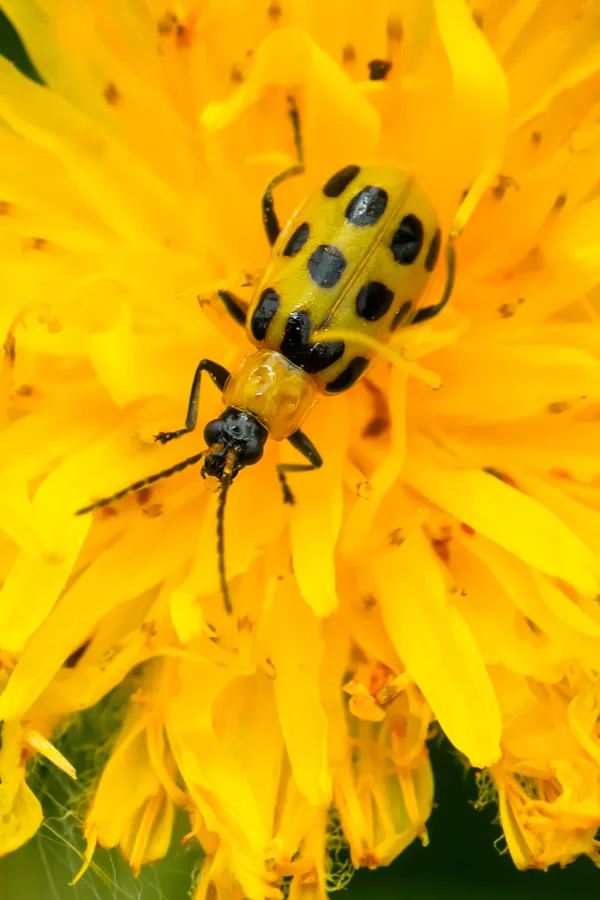
It’s amazing just how fast a cucumber crop can be decimated by these tiny creatures. Despite their name, cucumber beetles don’t just infect cucumber plants. In fact, they are happy to dine on other members of the cucurbit family, including squash, melons, and pumpkins too.
Today’s article covers three simple ways to ensure that your cucumber crop can stay safe all growing season long. There are even a few bonus tips at the end as well to help keep beetles from destroying your crop!
What Are Cucumber Beetles? – How To Eliminate Cucumber Beetles
Cucumber beetles are the most destructive and damaging pest when it comes to a cucumber crop. Not only do they damage the foliage of young plants, but they also enjoy snacking on the flowers as well. In addition, they will even chow down on cucumber fruit if given the opportunity.
These pests often begin to arrive in late May and June. They start by feeding on dandelions and other early flowering crops until cucumber plants are in the ground and growing.
How To Recognize Cucumber Beetles
There are six different cucumber beetles in the United States. However, there are two main types typically seen in gardens: the adult striped cucumber beetle and the adult spotted cucumber beetle.
Both types resemble a cross between a firefly and a ladybug. The adults grow to be around a ⅕ of an inch long and around a tenth of an inch wide. They feature yellow bodies with black heads and antennae.
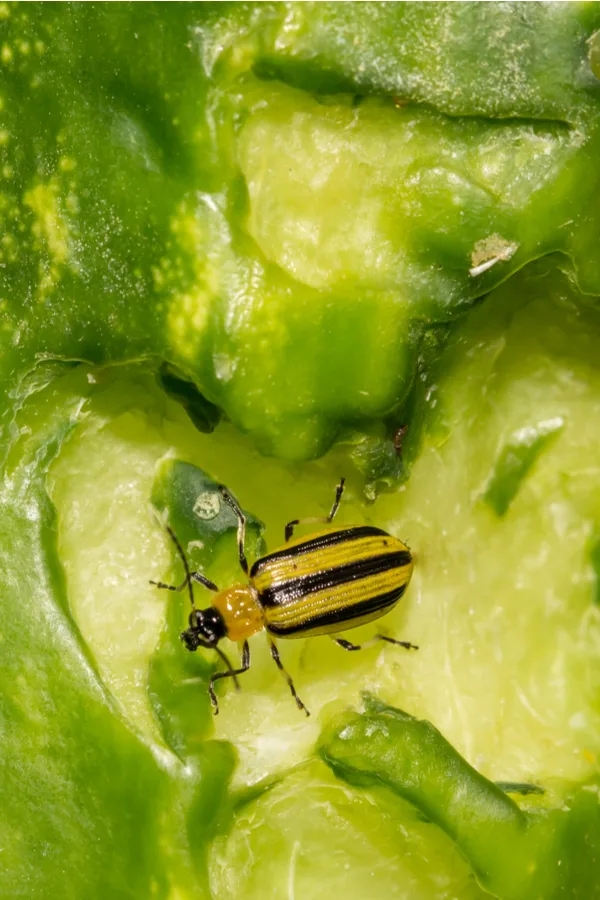
Adult striped beetles feature – you guessed it – three black stripes running from head to tail. On the other hand, the adult spotted beetles feature 12 black spots on their backs instead of the stripes.
Cucumber beetle eggs from both species are laid in groups around the base of host plants and are a pale yellowish-orange color. The larvae are cream-colored and grow to be around ⅜ of an inch long.
Cucumber Beetle Life Cycle
The frustrating part about a cucumber beetle is that the insect can cause damage to the plant at all stages of the plant’s lifecycle. And, in addition to the physical damage the insects do by eating the plants, they can also transmit bacterial wilt to your cucurbits.
After the eggs hatch, the larvae will feed on the underground roots and stems of their host plant. This could be the cucumber plants themselves, or a host plant such as dandelions. The larvae then turn into pupae in the soil. Later on during the summer, the pupae will hatch as adults.
The adults will feast on the leaves, stems, blossoms, and fruit of young and mature plants alike. The whole cycle of going from egg to adult takes around 40 to 60 days.
How To Recognize Damage – How To Eliminate Cucumber Beetles
In an otherwise healthy adult cucumber plant, a small infestation is relatively harmless and not fatal. However, a large number of cucumber beetles on new transplants or seedlings will often cause more issues than an established, adult plant.
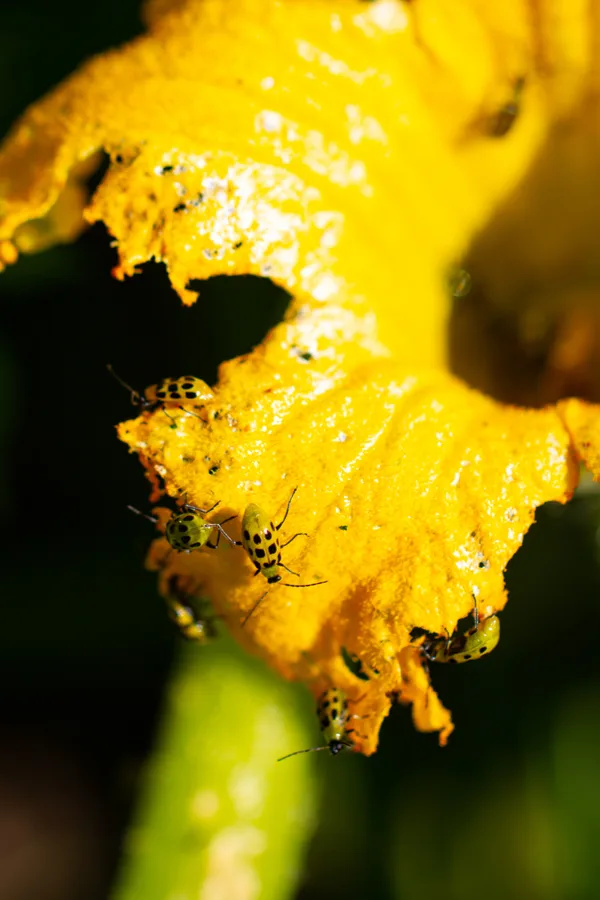
To identify an issue, you will often start to see holes in the foliage. Cucumber beetle damage will also cause yellowing and wilting of the leaves. The main stems lower on the plant may show cut lines from the larvae feeding.
If an infestation is feeding on the blossoms, you will notice damage to the blooms and a reduction in fruit production. The fruit itself will likely have scarring and pockmarks along the length of it where cucumber beetles might have been feasting.
Bacterial Wilt
Cucumber beetles can also be carriers of bacteria that cause bacterial wilt in cucurbits. This fatal bacteria gets into the plant’s vascular system. Plants cannot be saved once they are infected.
The plant’s foliage starts to wilt and also becomes discolored. Eventually, the plant dies altogether. This wilting will spread quickly once a plant is infected. It then only takes a few days before the plant dies.
Heads Up: Other issues may be in play if your cucumber plant is wilting besides bacterial wilt. Issues like dehydration, squash bugs, squash vine borers, or even just a warm sunny day may also cause cucumber plants to start to wilt. So don’t give up on your plants immediately after seeing signs of wilting.
3 Easy Ways To Eliminate Cucumber Beetles
Now that you know what cucumber beetles look like and how to recognize their damage, let’s figure out what you can do to get rid of these pests this growing season.
#1: Row or Plant Covers – Battle Cucumber Beetles
As with most insect infestations and diseases, prevention is the key to keeping your garden crops safe and healthy. One of the ways of preventing a cucumber beetle issue is by using row or plant covers on your plants.
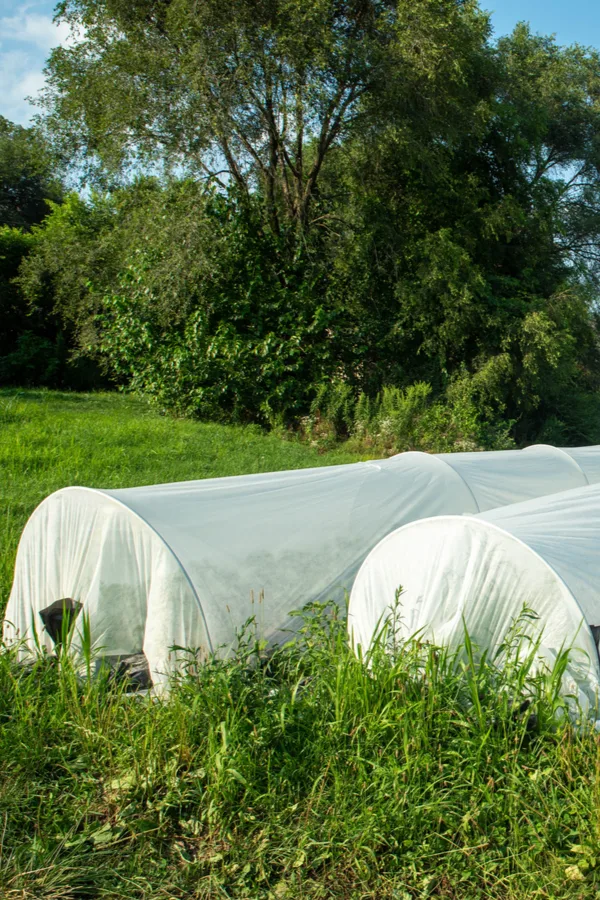
You can create a row cover by using a breathable, lightweight woven fabric. This fabric allows light and water to penetrate, but insects are too large to get to the plants. Since the fabric is lightweight, it won’t weigh down the foliage underneath.
You can purchase row covers in most garden centers or you can make your own homemade version. Use PVC piping to create arched supports along the top of plants and down the base of the rows. Be sure to secure the fabric to the soil so pests cannot get underneath.
Since the cucumber beetle larvae emerge in the middle of spring, you will want to get your row covers in place as soon as your seeds or plants are in the ground. Just remember to remove the row cover when plants start to bloom to allow for pollination.
#2: Planting A Sacrificial Crop – How To Eliminate Cucumber Beetles
While gardeners want all of their plants to grow healthy and strong, there are some times when a sacrificial crop can come into play.
A sacrificial crop is just what it sounds like: A plant that is placed in your garden to be killed or eaten instead of your more desired crops.
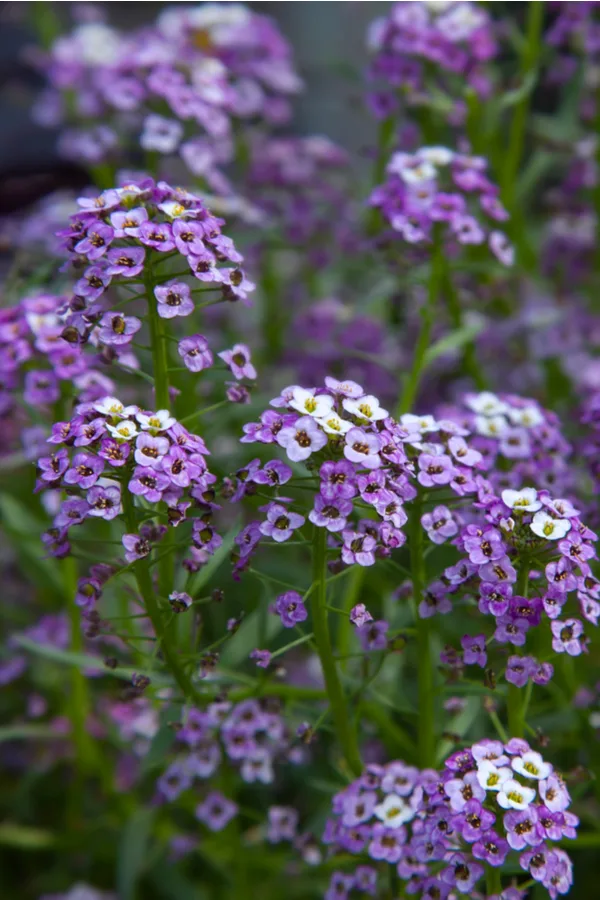
In the case of cucumber beetles, they actually enjoy feasting on sweet alyssum just as much if not more than your cucurbits. By planting sweet alyssum nearby, you increase the chances of the beetles attacking the flower instead of your cucumbers.
In addition, sweet alyssum also attracts many different beneficial natural predators of cucumber beetles to your garden. It also looks beautiful when blooming, too. Talk about your all-around beneficial companion plant!
#3: Neem Oil – How To Eliminate Cucumber Beetles
While you should try to avoid using any type of insecticide when possible, there are some natural sprays that work just as effectively. Using neem oil is a great way to quickly control a large population of cucumber beetles – naturally!
Neem oil is an all-natural liquid that is created by pressing the oil from the seeds of the neem tree. It is 100% safe, organic, and all-natural and it even works on other types of insects like aphids. The best part of all: It isn’t harmful to pollinators like bees and butterflies.
To learn everything you need to know about using neem oil, check out this article: “How To Use Neem Oil – The Organic Solution To Pest & Disease Control!”
Bonus Tips – How To Eliminate Cucumber Beetles
There are plenty of other ways to help reduce the number of cucumber beetles that infest your garden this growing season. Although the above ideas will work the best, you can also consider these bonus ideas as well to see what methods work best for you and your garden.
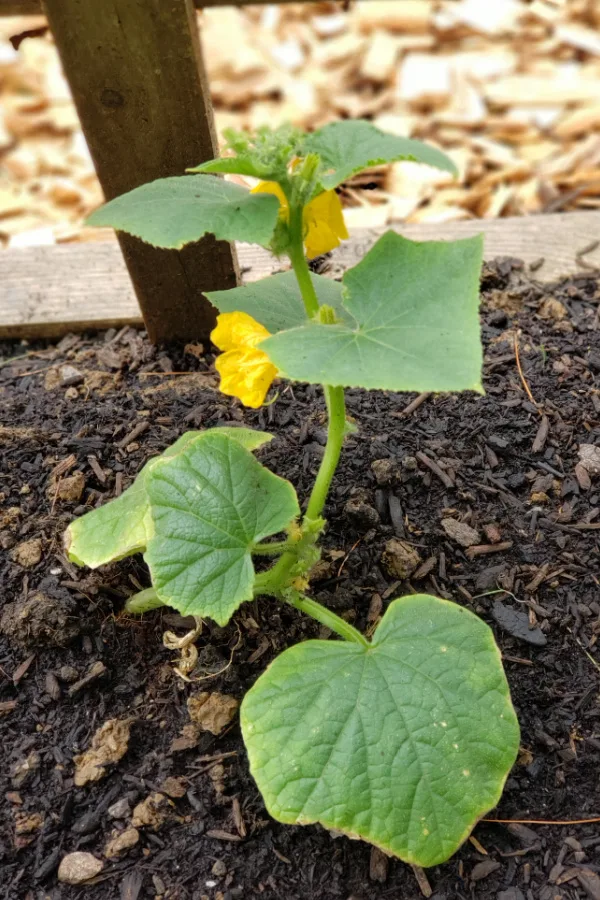
Delay Planting
If you have a longer growing season, consider planting your cucurbits later in the summer. Since the adults prefer younger sensitive plants, delaying planting will make sure your plants aren’t in the ground when the beetles are emerging.
The beetles will then move on to another food source and leave your garden alone. They will be out of the picture by the time you actually plant your cucumbers into the ground.
This works best if you start your cucumber plants indoors and then transplant them into the garden. The later in the summer you transplant, the better chances the beetles out of the picture. Just keep in mind the days to maturity for your cucumber variety so you don’t plant too late in the season.
Crop Rotation
Also be sure to rotate your garden crops every year. This is especially important if you plan on using a row cover for added protection.
Move your cucurbits as far away as possible from the location they grew in last year. Since some varieties of cucumber beetles overwinter their eggs, this will make it harder for the larvae to hatch and make their way to the plants.
There are also many other benefits to rotating your garden crops. You can read all about those benefits here.
Natural Predators
Encourage natural predators like soldier beetles, ladybugs, assassin bugs, braconid wasps, and some beneficial nematodes to visit your garden. These natural predators can be welcomed to your garden by planting nearby companion crops or plants these insects enjoy.
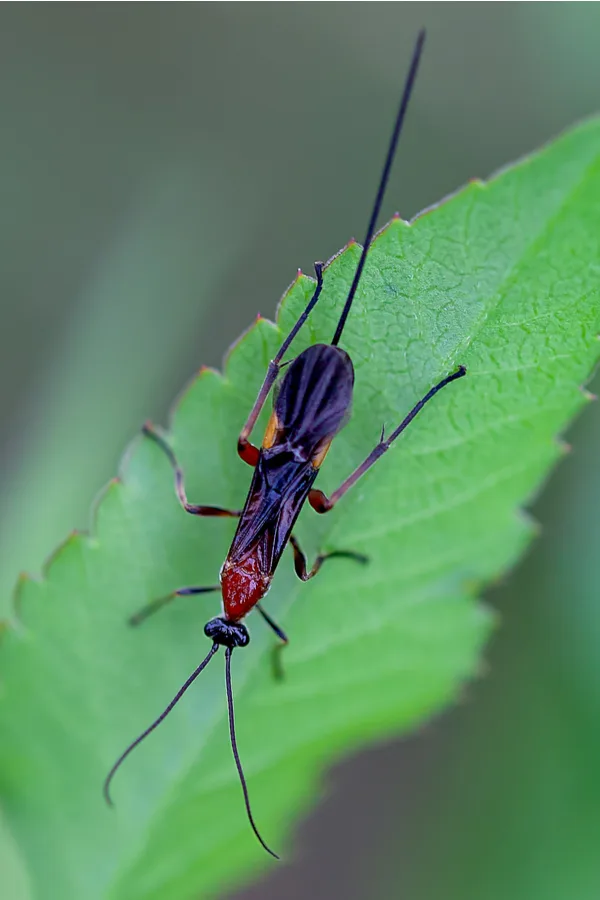
Manually Remove Them
Lastly, never underestimate the power of a little manual labor! If you start to see an insect infestation, you can manually remove visible larvae, eggs, and even adult bugs from your plants. Dispose of the insects to ensure they can’t come back.
Hopefully, by taking these tips into consideration, you will be on the winning side of the battle against cucumber beetles once and for all!
Follow Our Facebook Page For Even More Great Tips! Simple Garden Life Facebook Page
Simple Garden Life is a website dedicated to keeping gardening fun, simple and enjoyable! We publish two new articles each week along with a new garden podcast episode every two weeks. This article may contain affiliate links.
